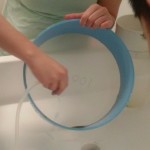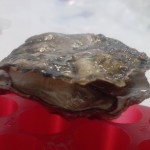The time has been flying by so fast, as our Research Experience class is now already in our fourth week of the quarter! Last week (April 16), we had our second lab day at Manchester Environmental Services National Lab. There, Puget Sound Restoration Fund researcher Ryan Crim has been showing us how PSRF is managing the conservation of the Olympia oyster. It is an amazing experience to be able to see how the hatchery operates, and to learn about the larval stages of the Olympia oyster.

The purpose of our second lab visit was to clean and feed our stained larvae from the previous week, as well as screen them by size to identify any deceased ones. Because of their age, they should be longer than 120μm. We screened the larvae first through this size screen, followed by a 100μm screen. Any larvae that made it through the 100μm were considered deceased, meaning that they have not grown since we collected them. We then placed our two sample populations of oysters back into their containers with clean seawater and about 1L each of algae to eat.
We then took two 0.5mL samples from both the South Sound and the Port Gamble larvae. Each of the four of us would do a hand count of how many larvae we saw in each sample under the microscope. With these numbers, we calculated an average number of larvae per mL, which gave us an estimate of the total larvae remaining if each of our samples. We estimated ~16,000 in our sample from Port Gamble broodstock, and ~19,000 in our sample from South Sound broodstock.

The other purpose of our second lab visit was to test for the best method of sedating our Olympia oysters. Epsom salt is what has been used in the past to sedate and relax the oysters, so that they may be checked for any brooding larvae. When the oysters are brooding, they become white sic (younger brood), gray sic, or black sic (just before expelling brood). With Epsom salt, the oysters relax and open up their mouths which allow us to use something (in our case zip ties) to swipe inside of their shells to check if they are brooding. This method does not result in any oyster mortalities.
We tested four different concentrations of Epsom salt: 75g/L, 100g/L, 125g/L, and 150g/L, to see which would lead to the fastest results without harming the oysters. The result of this experiment showed the 100g/L concentration was the most effective for our oysters. Based on these results, we would use the 100g/L concentration of Epsom salt for future sedation and checking for brooding.
